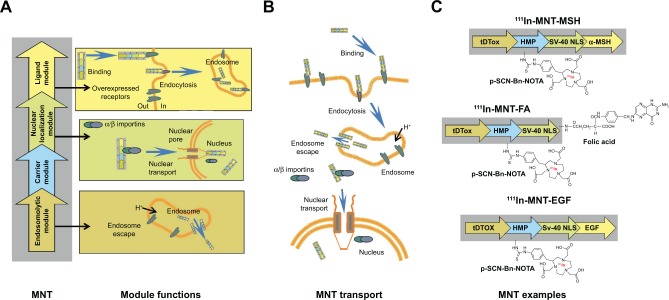Figure 1.
Schematic presentation of MNTs used in the study.
Notes: (A) Principal scheme of MNT structure and representation of the function of each module. (B) Schematic presentation of MNT transport from the target cell surface to its nucleus. (C) MNTs used in the current study. MNT is designed to recognize and bind through its ligand module to internalizable receptors expressed on the surface of target cells; following subsequent internalization by receptor-mediated endocytosis, the MNT escapes from the endosomes with the help of its endosomolytic module; finally, the MNT binds through its nuclear localization signal module to importins in the hyaloplasm and this complex is transported through the nuclear pore into the target cell nucleus. MSH targeted to melanocortin receptor-1, EGF targeted to EGF receptor, or FA targeted to folate receptors served as different ligand modules; tDTox served as the endosomolytic module, the optimized SV-40 large T-antigen NLS was responsible for importin binding and transport into the nucleus through nuclear pore, and Escherichia coli HMP was used as the carrier module.
Abbreviations: EGF, epidermal growth factor; FA, folic acid; HMP, hemoglobin-like protein; MNTs, modular nanotransporters; MSH, α-melanocyte-stimulation hormone; NLS, nuclear localization sequence; p-SCN-Bn-NOTA, chelator S-2-(4-isothiocyanatobenzyl)-1,4,7-triazacyclononane-1,4,7-triacetic acid; tDTox, the diphtheria toxin translocation domain.

